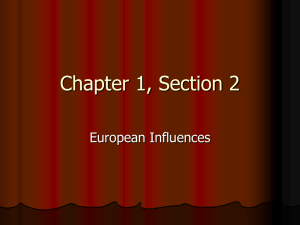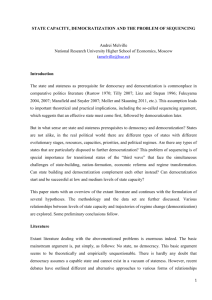Account for the shift towards democratic forms of government in
advertisement
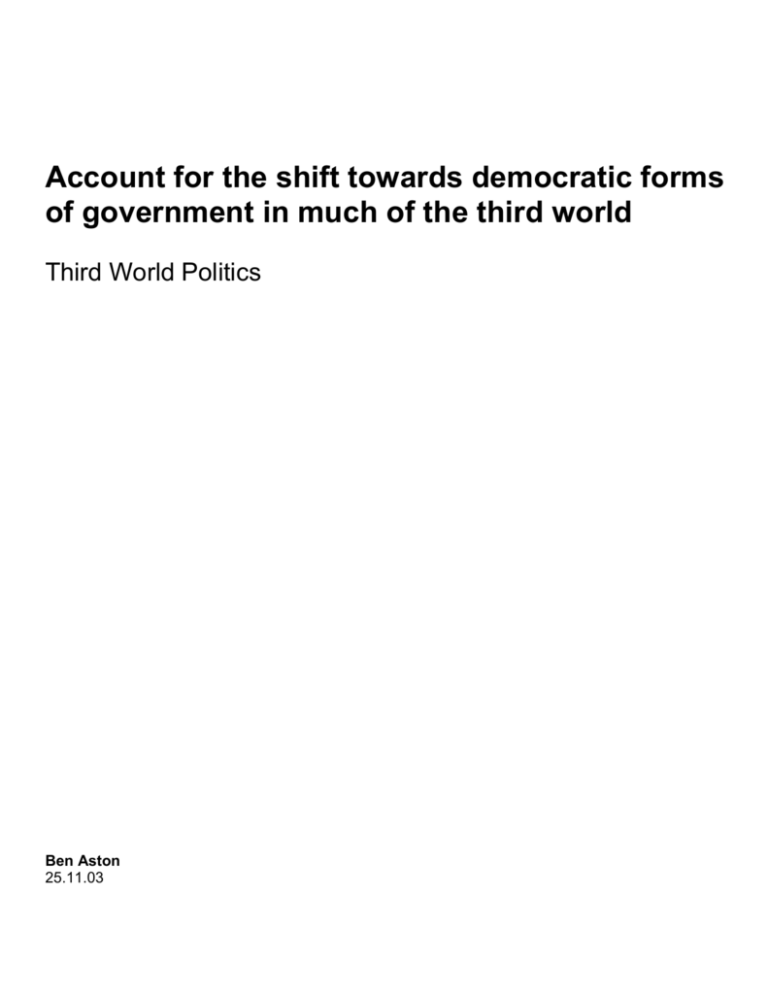
Account for the shift towards democratic forms of government in much of the third world Third World Politics Ben Aston 25.11.03 “Democracy is the worst form of government, except for all the others that have been tried.”1 The last twenty five years has seen a distinct trend towards away from dictatorship and one party states rule towards liberal democracy. The causes of this change vary from time and space; from class in the early 19th Century, to more recently, social conflict and external influence.2 This essay will examine some of the theories devised to explain the causes for this trend. Defining what exactly is meant by the term ‘third world’ is no simple task. There are numerous explanations of what exactly constitutes a ‘third world’ country. However, for the purposes of this essay, the third world will be understood in a broad sense to mean the underdeveloped and politically unaligned developing countries of Asia and Africa and Latin America. Additionally it is necessary to define exactly what is understood as democracy and democratic government. Democratic forms of government will be understood to mean a system of elected government in which the supreme power is invested in the body of citizens although exercised on their behalf by the elected representatives. This is not a particularly rigorous definition but in identifying the shift towards democracy it will become apparent that different extents of democracy could simply be different stages in the shift. There are numerous theories which try to explain the trend towards democratization. Huntington’s wave theory is widely accepted as providing a basis for analysis. Huntington’s wave theory suggests there are three waves which make up the democratization process as countries shift towards democratic governance. “A wave of democratization is a group of transitions from non-democratic to democratic regimes that occurs within a specified period and that significantly outnumbers transitions in the opposite direction in the same period.”3 Huntington believed that the existence of waves meant the trend of democratization was global and therefore global factors were at work. Huntington suggests the first of these waves stated at the beginning of the nineteenth century in America, when the principal challengers of democracy and communism came from Fascism. Mussolini’s control of Italy in 1922 began the reverse of this wave so that by 1942 the number of democracies had fallen from about thirty to twelve in the world. The second wave was considerably 1 Winston Churchill J Grugel, Democratization: a Critical Introduction, Palgrave 2001, p. 32 3 S Huntington, How Countries Democratize, Political Science Quarterly Vol 106, no4, 1991, p. 579 2 shorter, beginning with the defeat of the Axis powers in 1945 which led to the Allies pushing through democratisation in the occupied territories of Germany, Austria and Japan. The reverse of this wave was in the 1960’s when military coups and dictatorships ended the shift to democratization. The third wave began with the democratization of Portugal in 1974 which was followed soon after by Spain and Greece. Huntington identifies five changes in the world that paved the way for this third wave of transitions. Firstly, authoritarian governments faced a growing problem of legitimacy in that they were undermined by either poor economic performance or unable to cope with military defeat. Secondly, the economic boom of the 1960’s lifted expectations and led to demands in improved living standards, levels of education, and urbanization, while also raising civic expectations and the ability to express them. Thirdly, liberalisation of the Catholic Church made the church more prone to oppose governmental authoritarianism than defend the status quo and rather act as proponents of reform. Fourthly, the push to promote human rights and democracy by external non-governmental organizations actors such as the EU and the European Community. Fifthly, the "snowballing" or demonstration effects, a product of new global communication, of democratisation in other countries. Huntington identifies four general types of transitions to explain the shift towards democracy. Firstly, transformations such as in Spain, India, Hungary, and Brazil where the elites in power took the lead in bringing about democracy. Secondly, replacements as in East Germany, Portugal, Romania, and Argentina where opposition groups took the lead in bringing about democracy; Thirdly, transplacements such as in Poland, Czechoslovakia, Bolivia, and Nicaragua where democratization occurred from joint action by government and opposition groups. Fourthly, interventions as in Grenada and Panama where democratic institutions were imposed by an outside power. Huntington also discusses various aspects of democratic stabilisation and the prospects of consolidation in fledgling third wave democracies. He outlines a number of conditions that have favoured or are favouring the consolidation of new democracies. He suggests that the experience of a previous effort at democratization, even if it failed can help consolidate democracy. Similar to modernist theory, Huntington believes a high level of economic development is beneficial to young democracies. Ensuring the transition is a success without violence and outside assistance helps establish the democracy in its own right. According to Huntington, ensuring the early timing of the transition to democracy, relative to a worldwide "wave," indicating that the drive to democracy derived primarily from indigenous rather than outside influences are key in consolidating democracy. Huntington’s wave theory does much to explain in a broad sense the shift to democratisation. However, the waves seem to overlap and the definitions of each wave are quite loose. Equally, Huntington’s definition of democracy is very generous; elections however, are not necessarily an appropriate indicator of the beginning of democracy. Critics of the wave theory suggest that he fails to capture different explanations for democratization. Consequently, three other theories; modernisation, structuralism and transition will be explored to examine other accounts of the shift to democratization. Modernisation theory is based on Gidden’s idea that modernity is spreading across the world creating a global culture thus linking democratisation with globalisation.4 Essentially, the idea is the belief that modern society and thus democracy is a product of capitalism. Lipset claimed that an increase in capitalism and materialism led to an increase in democracy. The reason for this is because capitalism produces wealth which in turn creates an educated middle class who produce cultural changes such as increased secularisation which advances the demand for democracy. “A large middle class plays a mitigating role in moderating conflict since it is able to reward moderate and democratic parties and penalize extremist groups.” 5 The modernization theory adopts an ahistorical approach in that it believes that they theory can transcend space and time. This has been criticised as being to ethnocentric and too simplistic a model to understand the third world transition to democracy. Lipset’s methodology, using only the variables of wealth and education are considered by many to be too simplistic and inconclusive; they suggest instead that rather that the relationship is correlative rather than causal. Similarly Leftwich argued that economic development, whether in a democratic political setting or not, will, in the long term, inevitably produce democracy.6 ‘Structuralism’ and ‘historical sociology’ are often used interchangeably as theories of democratization. Rather than the modernist approach which seeks to predict democratization, 4 A Giddens, The consequences of modernity, 1990 Seymour Martin 1959. Social prerequisites of democracy: Economic development and political legitimacy. American Political Science Review 53: p.78 6 A Leftwich, Part 1 Theory and Controversy, Democracy and Development, Polity Press, p.6-10 5 Lipset, structuralism is more concerned with explaining outcomes. ‘Structuralists trace the transformation of the state through class conflict over time, in order to explain how democracy – which they see as state transformation – has occurred.’7 Conversely to modernization, they understand the process of democratization as a result of reforms on a capitalist state rather than an automatic development of capitalism. Transition theory emphasises the importance of politics of change, focussing on liberalization, transition and consolidation in the shift to democratization. Rather than focussing on economy, history and development as in modernization, the transition school believes that it is individual actors, structure and class relations who are the real agents of change.8 However, critics of transition theory suggest that it is too elitist and empirical. Additionally, critics believe that although their explanation ‘work’s for southern Europe and Latin America it cannot be used to explain culturally, politically and economically different regions such as Africa and China. Although the theories identified herein offer a varied account of the causes of democratization they fail to explain why democracy sometimes succeeds and why it fails. Huntington’s wave theory comes closest to recognising relapse although this largely fails to account for contemporary democracies which have slipped back into one party state or authoritarian regimes such as Pakistan. It would be naïve to believe that one theory could fully explain the shift towards democratisation. Without a doubt there democratization is a process influenced by myriad factors including culture, individual and collective action, social conflict as well as international factors. Equally, attempting to explain the global shift of democratization without specifically accounting for regional causation is naïve. However, I would suggest the modernisation approach offers the most logical explanation for the global trend towards democratic forms of government in the third world. 7 8 J Grugel, Democratization: a Critical Introduction, Palgrave 2001, p. 52 J Grugel, Democratization: a Critical Introduction, Palgrave 2001, p. 57
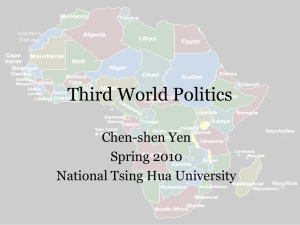
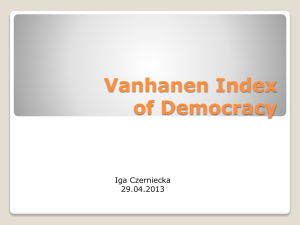
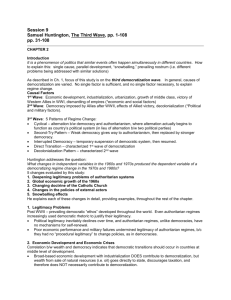

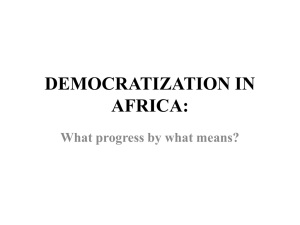
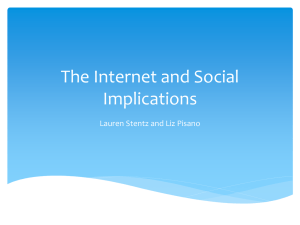
![“The Progress of invention is really a threat [to monarchy]. Whenever](http://s2.studylib.net/store/data/005328855_1-dcf2226918c1b7efad661cb19485529d-300x300.png)


